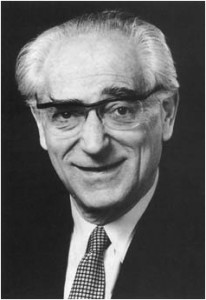
Gerischer’s immense contributions continue to leave an indelible mark, not only in electrochemistry, but also in physical chemistry and materials chemistry.
An article by Adam Heller, Dieter Kolb, and Krishnan Rajeshwar in the Fall 2010 issue of Interface.
Heinz Gerischer was born on March 31, 1919 in Wittenberg, Germany. He studied chemistry at the University of Leipzig between 1937 and 1944 with a two-year interruption because of military service. In 1942, he was expelled from the German Army because his mother was born Jewish; he was thus found “undeserving to have a part in the great victories of the German Army.” The war years were difficult for Gerischer and his mother committed suicide on the eve of her 65th birthday, in 1943. His only sister, Ruth (born in 1913), lived underground after escaping from a Gestapo prison and was subsequently killed in an air raid in 1944.
In Leipzig, Gerischer joined the group of Karl Friedrich Bonhoeffer, a member of a distinguished family, members of whom were persecuted and murdered because of opposition to Nazi ideology. Bonhoeffer descended from an illustrious chemical lineage of Wilhelm Ostwald (1853-1932) and Walther Hermann Nernst (1864-1941), and kindled Gerischer’s interest in electrochemistry, supervising his doctoral work on periodic (oscillating) reactions on electrode surfaces, completed in 1946. He followed Bonhoeffer to Berlin where his PhD supervisor had accepted the directorship of the Institute of Physical Chemistry at the Humboldt University, and also became the department head at the Kaiser Wilhelm Institute for Physical Chemistry in Berlin-Dahlem (later the Fritz Haber Institute). Gerischer himself was appointed as an “Assistent.” Many years later, Gerischer would return to this distinguished institution as its director. With the Berlin Blockade and the prevailing economic conditions the post-war research was carried out under extremely difficult conditions.


